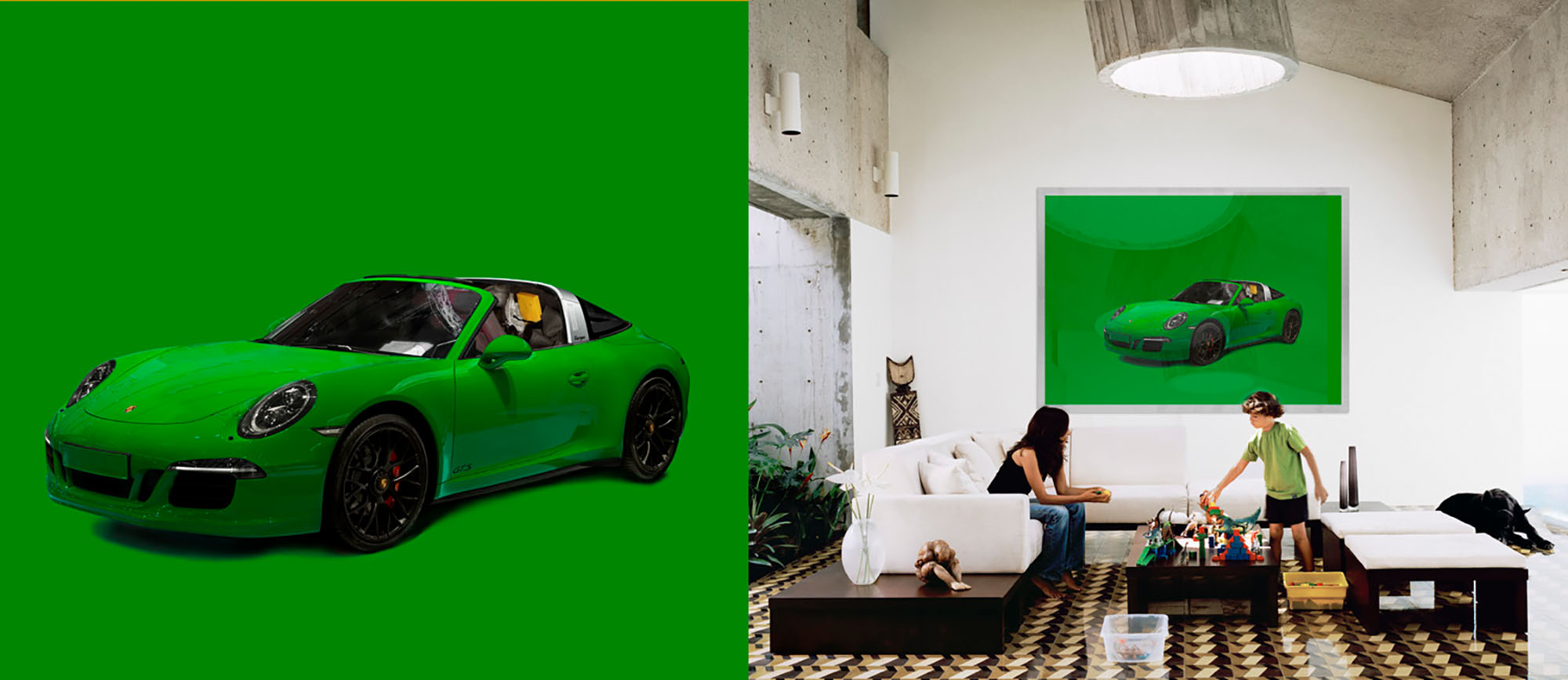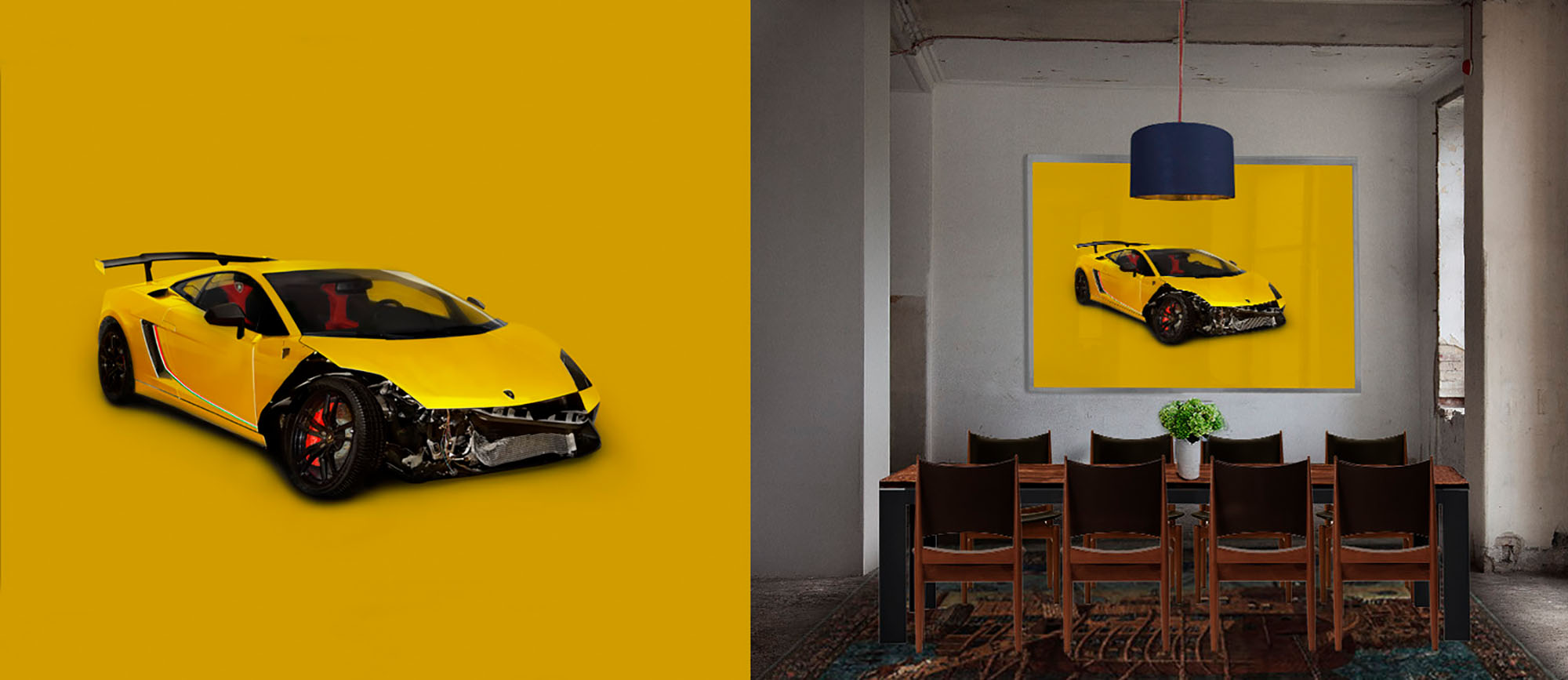CAMP IT UP
Camp it up
Der Untertitel von CAMP IT UP könnte To perform a play in an exaggerated or affected manner sein. Es stellt sich Frage: sind die Besitzer der Fahrzeuge gemeint oder die Protagonisten einer hedonistischen Autoindustrie, die sich bewußt auf eine übertriebene Art und Weise, in einem lustvollen Spiel ein letztes Mal in Szene setzen wollen?
Für Winkhaus's neuen Arbeiten hätte es keinen zutreffenderen Titel geben können. In CAMP IT UP verschmelzen in gewohnter Neo Pop Manier strahlende Automobile der Luxusmarken mit dem gleichfarbigen Hintergrund. Wie bereits in My pleasure to serve you ist der Bezug auf das Oeuvre von Andy Warhol erkennbar. Auf den ersten Blick wirken diese großformatig komponierten Bilder mit des Menschen liebsten Spielzeug wie Werbeplakate: perfekt und wirksam dargestellt, ikonographisch aufgeladen, erotisch protzig und laut. Roland Barthes beschreibt das Auto als „das genaue Äquivalent der großen Kathedralen“.
Bei näherem Betrachten sind die Kultobjekte der Begierde und Symbole individueller Freiheit nicht nur aus ihren Funktionszusammenhängen herausgerissen, sondern auch beschädigt und verstummt. Wir hören den universell bekannten Sound dieser stets auffallenden Autos nicht mehr. Haben sie ausgedient? Winkhaus parkt sie um und präsentiert sie als grelle und vieldeutige Skulpturen. Sie tragen Spuren von Unfallszenarien und haben ein rätselhaftes Innenleben - sind es Hinweise individueller Geschichten über deren Leben? Oder beabsichtigt die Künstlerin für die verformten Plastiken auf ihre irritierende und auch provozierende Weise neue Besitzer zu finden, um auf diese Weise eine gewisse Unsterblichkeit dieser Luxusikonen im Stilstand zu verleihen?
Das Auto, von dem Wolf Vostell 1969 sagte, es sei die Plastik des 20. Jh., bleibt auch bis in die Gegenwart beliebtes Spielzeug künstlerischer Positionen, wobei die von Künstlerinnen eher in der Minderheit sind. Winkhaus‘s „car sculptures“ erinnern mehr an das rote Ready-made Giulietta von Betrand Lavier oder auch an die zerbeulten Hauben von Sylvie Fleury als an die makellosen Oberflächen in den airbrushed paintings von Robert Longo. Auf eine durchaus spielerische Art beraubt Winkhaus sie ihrer Funktion, vor allem ihres Statussymbols und dem sportivem Lifestyle. Dabei verzichtet sie in der zerstörten Darstellung nicht gänzlich auf ihre durchaus immer noch starke Anziehungskraft, bedingt durch den Glanz in der Material- und Formästhetik. Ihre„Manipulationen“ sind nicht als Demontage zu betrachten. Vielmehr bleiben sie als Metaphern für Technik und mit ihren exzentrischen und futuristischen Formen kreativem Designs unübersehbar und physisch spürbar präsent: sie überleben auch nach dem mobilen Erlebnis.
Stehen meistens sozialkritische und ökonomische Aspekte im Vordergrund künstlerischer Auseinandersetzungen mit dem Auto, verzichtet CAMP IT UP auf den gesellschaftspolitischen Kommentar, ist eher retrospektiver Blick und reflektiert vielmehr eine übertriebenen Autoindustrie, die heute bedingt durch die Verkehrspolitik zunehmend nutzlos geworden zu sein scheint. Das einstige Objekt der Begierde und Ausdruck bestimmter Lebensqualität wird als Konsequenz daraus möglicherweise unfreiwillig zum Sammlerobjekt und findet als verstummter Zeuge industriellen Fortschritts jenseits von Rausch und Geschwindigkeit in den Garagen seinen neuen reglosen Platz.
Text: Harald Theiss, Kurator | www.haraldtheiss.de
The subtitle of CAMP IT UP could be To perform a play in an exaggerated or affected manner. The question arises: are the owners of the vehicles meant or the protagonists of a hedonistic car industry who deliberately want to stage themselves one last time in an exaggerated way, in a pleasurable game?
For Winkhaus's new works there could not have been a more appropriate title. In CAMP IT UP, radiant cars of the luxury brands merge with the background of the same color in the usual neo-pop manner. As in My pleasure to serve you, the reference to the oeuvre of Andy Warhol is recognizable. At first glance, these large-format images of people's favourite toys seem like advertising posters: perfectly and effectively depicted, iconographically charged, erotically ostentatious and loud. Roland Barthes describes the car as "the exact equivalent of the great cathedrals.
On closer inspection, the cult objects of desire and symbols of individual freedom are not only torn out of their functional contexts, but are also damaged and silenced. We no longer hear the universally known sound of these always striking cars. Have they had their day? Winkhaus re-parks them and presents them as garish and ambiguous sculptures. They bear traces of accident scenarios and have a mysterious inner life - are they indications of individual stories about their lives? Or does the artist intend to find new owners for the deformed sculptures in her irritating and provocative way in order to lend a certain immortality to these luxurious icons in style?
The car, which Wolf Vostell said in 1969 was the sculpture of the 20th century, remains a popular toy of artistic positions even to the present day, although women artists tend to be in the minority. Winkhaus's "car sculptures" are more reminiscent of Betrand Lavier's red Ready-made Giulietta or Sylvie Fleury's dented hoods than of the flawless surfaces in Robert Longo's airbrushed paintings. In a playful way, Winkhaus robs them of their function, above all their status symbol and sporty lifestyle. In the destroyed representation, however, she does not completely renounce her still strong attraction, caused by the brilliance of the material and form aesthetics. Their "manipulations" are not to be regarded as dismantling. Rather, they remain unmistakably and physically noticeably present as metaphors for technology and with their eccentric and futuristic forms of creative design: they survive even after the mobile experience.
While socio-critical and economic aspects are mostly at the forefront of artistic discussions about the car, CAMP IT UP dispenses with socio-political commentary, is rather a retrospective view and rather reflects an exaggerated car industry, which today seems to have become increasingly useless as a result of transport policy. As a consequence, the former object of desire and expression of certain quality of life may involuntarily become a collector's item and find its new place in the garages as a silent witness of industrial progress beyond intoxication and speed.
Text: Harald Theiss, Kurator | www.haraldtheiss.de







